同济大学:《空气动力学》课程电子教案(课件讲稿)Chapter 3 Fundamentals of Inviscid Inviscid, Incompressible Flow
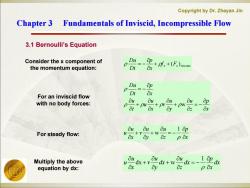
Copyright by Dr.Zheyan Jin Chapter 3 Fundamentals of Inviscid,Incompressible Flow 3.1 Bernoulli's Equation Consider the x component of the momentum equation: Du=_0p+pf,+(F.vw Dt dx Du=-卫 For an inviscid flow Dt dx with no body forces: p+pm0+pm0tv-卫 Ox dy du 1 ap For steady flow: p ox Multiply the above ou dx+v u ou dx+w dx = 1卫dk equation by dx: C D Ox
Copyright by Dr. Zheyan Jin Chapter 3 Fundamentals of Chapter 3 Fundamentals of Inviscid Inviscid, Incompressible Flow , Incompressible Flow 3.1 Bernoulli’s Equation For steady flow: Consider the x component of the momentum equation: x p z u y u v x u u 1 w x p z u y u v x u u t u x p Dt Du w x Fx viscous f x p Dt Du ( ) For an inviscid flow with no body forces: Multiply the above equation by dx: dx x p dx z u dx y u v x u u 1 dx w
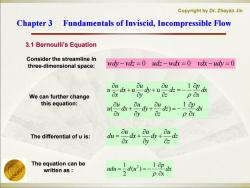
Copyright by Dr.Zheyan Jin Chapter 3 Fundamentals of Inviscid,Incompressible Flow 3.1 Bernoulli's Equation Consider the streamline in three-dimensional space: wdy-vdz=0 udz-wdx=0 vdx-udy =0 ou dxu u ou dyu =-1pk We can further change Ox ay 0z pox this equation: ou dxy ou dy* db)=-12dh pOx The differential of u is: du= ou dx 8 ou dy aud也 oy dz The equation can be 1 written as: udu =-d(u2)=-- 1卫k 2 pox
Copyright by Dr. Zheyan Jin Chapter 3 Fundamentals of Chapter 3 Fundamentals of Inviscid Inviscid, Incompressible Flow , Incompressible Flow 3.1 Bernoulli’s Equation The differential of u is: Consider the streamline in three-dimensional space: dx x p dz z u dy y u dx x u u dx x p dz z u dy y u dx u x u u 1 ( ) 1 u dz z u dy y u dx x u du dx x p udu d u 1 ( ) 2 1 2 We can further change this equation: wdy vdz 0 udz wdx 0 vdx udy 0 The equation can be written as :
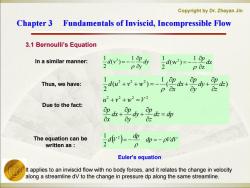
Copyright by Dr.Zheyan Jin Chapter 3 Fundamentals of Inviscid,Incompressible Flow 3.1 Bernoulli's Equation In a similar manner: 2w)=-12d w2)=-192d poy 2 P OZ 1 Thus,we have: w+2+w)=0++ Oy op d2) 2+v2+w2=V2 Due to the fact: p+吧d山+ 卫dk=dp The equation can be dp=-pVdv written as p Euler's equation It applies to an inviscid flow with no body forces,and it relates the change in velocity along a streamline dV to the change in pressure dp along the same streamline
Copyright by Dr. Zheyan Jin Chapter 3 Fundamentals of Chapter 3 Fundamentals of Inviscid Inviscid, Incompressible Flow , Incompressible Flow 3.1 Bernoulli’s Equation Due to the fact: In a similar manner: dp VdV dp d V 2 2 1 dz dp z p dy y p dx x p u v w V dz z p dy y p dx x p d u v w 2 2 2 2 2 2 2 ( ) 1 ( ) 2 1 Thus, w e have: The equation can be written as : dy p d y 1 (v ) 2 1 2 z z 1 ( w ) 2 1 2 d p d Euler’s equation It applies to an inviscid flow with no body forces, and it relates the change in velocity along a streamline dV to the change in pressure dp along the same streamline
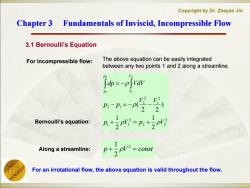
Copyright by Dr.Zheyan Jin Chapter 3 Fundamentals of Inviscid,Incompressible Flow 3.1 Bernoulli's Equation For incompressible flow: The above equation can be easily integrated between any two points 1 and 2 along a streamline. V2 Sdp=-p[vdv V2 P,-=-p( Bernoulli's equation: n+2p=n+p Along a streamline: =const For an irrotational flow,the above equation is valid throughout the flow
Copyright by Dr. Zheyan Jin Chapter 3 Fundamentals of Chapter 3 Fundamentals of Inviscid Inviscid, Incompressible Flow , Incompressible Flow 3.1 Bernoulli’s Equation Bernoulli’s equation: For incompressible flow: 2 2 2 2 1 1 2 1 2 2 2 1 2 1 2 1 ) 2 2 ( 2 1 2 1 p V p V V V p p dp VdV V V p p Along a streamline: p V const 2 2 1 For an irrotational flow, the above equation is valid throughout the flow. The above equation can be easily integrated between any two points 1 and 2 along a streamline
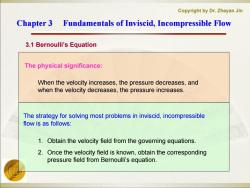
Copyright by Dr.Zheyan Jin Chapter 3 Fundamentals of Inviscid,Incompressible Flow 3.1 Bernoulli's Equation The physical significance: When the velocity increases,the pressure decreases,and when the velocity decreases,the pressure increases. The strategy for solving most problems in inviscid,incompressible flow is as follows: 1.Obtain the velocity field from the governing equations. 2.Once the velocity field is known,obtain the corresponding pressure field from Bernoulli's equation
Copyright by Dr. Zheyan Jin Chapter 3 Fundamentals of Chapter 3 Fundamentals of Inviscid Inviscid, Incompressible Flow , Incompressible Flow 3.1 Bernoulli’s Equation The strategy for solving most problems in inviscid, incompressible flow is as follows: The physical significance: 1. Obtain the velocity field from the governing equations. 2. Once the velocity field is known, obtain the corresponding pressure field from Bernoulli’s equation. When the velocity increases, the pressure decreases, and when the velocity decreases, the pressure increases
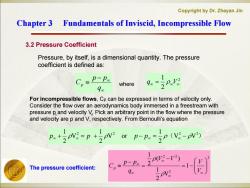
Copyright by Dr.Zheyan Jin Chapter 3 Fundamentals of Inviscid,Incompressible Flow 3.2 Pressure Coefficient Pressure,by itself,is a dimensional quantity.The pressure coefficient is defined as: C。=P-p2 1 where qoo For incompressible flows,Cp can be expressed in terms of velocity only Consider the flow over an aerodynamics body immersed in a freestream with pressure p and velocity VPick an arbitrary point in the flow where the pressure and velocity are p and V,respectively.From Bernoulli's equation P.+V:-P+V:OF P-P.-0 (V-PV) 2p-2 The pressure coefficient: 1
Copyright by Dr. Zheyan Jin Chapter 3 Fundamentals of Chapter 3 Fundamentals of Inviscid Inviscid, Incompressible Flow , Incompressible Flow 3.2 Pressure Coefficient For incompressible flows, Cp can be expressed in terms of velocity only. Consider the flow over an aerodynamics body immersed in a freestream with pressure p ͚and velocity V͚. Pick an arbitrary point in the flow where the pressure and velocity are p and V, respectively. From Bernoulli’s equation where 2 2 1 V q q p p Cp 2 2 ( V 2 V 2 ) 2 1 V or 2 1 V 2 1 p p p p The pressure coefficient: Pressure, by itself, is a dimensional quantity. The pressure coefficient is defined as: 2 2 2 2 1 V 2 1 ( ) 2 1 V V V V q p p Cp
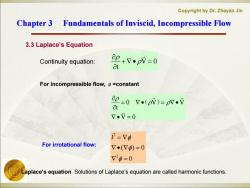
Copyright by Dr.Zheyan Jin Chapter 3 Fundamentals of Inviscid,Incompressible Flow 3.3 Laplace's Equation Continuity equation: +v.pV=0 t For incompressible flow,p =constant ap=0、 e(pV)=pv.V at 7.V=0 币=V中 For irrotational flow: 7·(V)=0 7b=0 Laplace's equation.Solutions of Laplace's equation are called harmonic functions
Copyright by Dr. Zheyan Jin Chapter 3 Fundamentals of Chapter 3 Fundamentals of Inviscid Inviscid, Incompressible Flow , Incompressible Flow 3.3 Laplace’s Equation Laplace’s equation. Solutions of Laplace’s equation are called harmonic functions. For incompressible flow, ρ=constant V 0 0 V V t ( ) V 0 t 0 ( ) 0 2 V For irrotational flow: Continuity equation:
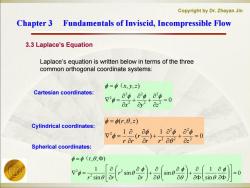
Copyright by Dr.Zheyan Jin Chapter 3 Fundamentals of Inviscid,Incompressible Flow 3.3 Laplace's Equation Laplace's equation is written below in terms of the three common orthogonal coordinate systems: 中=φ(x,y,2) Cartesian coordinates: v0=0+8,o' Oxoo =0 p=(t,0,z) Cylindrical coordinates: vb=18 o 、,1a2中,a2 -(r =0 r2a02 0z2 Spherical coordinates: =(r,0,Φ) 1 7= 2 a a 1 in sin rsine a0 Φ sin0oΦ
Copyright by Dr. Zheyan Jin Chapter 3 Fundamentals of Chapter 3 Fundamentals of Inviscid Inviscid, Incompressible Flow , Incompressible Flow 3.3 Laplace’s Equation 0 , , ) 2 2 2 2 2 2 2 x y z x y z ( 0 1 ( ) 1 ( , , ) 2 2 2 2 2 2 r r z r r r r z Cartesian coordinates: Laplace’s equation is written below in terms of the three common orthogonal coordinate systems: Cylindrical coordinates: Spherical coordinates: 0 sin 1 sin sin sin 1 r, , ) 2 2 2 r r r r (
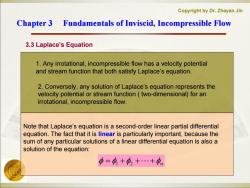
Copyright by Dr.Zheyan Jin Chapter 3 Fundamentals of Inviscid,Incompressible Flow 3.3 Laplace's Equation 1.Any irrotational,incompressible flow has a velocity potential and stream function that both satisfy Laplace's equation. 2.Conversely,any solution of Laplace's equation represents the velocity potential or stream function(two-dimensional)for an irrotational,incompressible flow. Note that Laplace's equation is a second-order linear partial differential equation.The fact that it is linear is particularly important,because the sum of any particular solutions of a linear differential equation is also a solution of the equation: 0=4+42+…+9
Copyright by Dr. Zheyan Jin Chapter 3 Fundamentals of Chapter 3 Fundamentals of Inviscid Inviscid, Incompressible Flow , Incompressible Flow 3.3 Laplace’s Equation 1 2 n 1. Any irrotational, incompressible flow has a velocity potential and stream function that both satisfy Laplace’s equation. Note that Laplace’s equation is a second-order linear partial differential equation. The fact that it is linear is particularly important, because the sum of any particular solutions of a linear differential equation is also a solution of the equation: 2. Conversely, any solution of Laplace’s equation represents the velocity potential or stream function ( two-dimensional) for an irrotational, incompressible flow
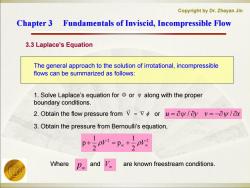
Copyright by Dr.Zheyan Jin Chapter 3 Fundamentals of Inviscid,Incompressible Flow 3.3 Laplace's Equation The general approach to the solution of irrotational,incompressible flows can be summarized as follows: 1.Solve Laplace's equation for or w along with the proper boundary conditions. 2.Obtain the flow pressure from V=or u=du/dy v=-dy/x 3.Obtain the pressure from Bernoulli's equation, 1 p+pV2=P.+pV2 2 Where P and are known freestream conditions
Copyright by Dr. Zheyan Jin Chapter 3 Fundamentals of Chapter 3 Fundamentals of Inviscid Inviscid, Incompressible Flow , Incompressible Flow 3.3 Laplace’s Equation 1. Solve Laplace’s equation for Φ or ψ along with the proper boundary conditions. 2. Obtain the flow pressure from The general approach to the solution of irrotational, incompressible flows can be summarized as follows: V u / y v / x 2 2 2 1 p 2 1 p V V p V or 3. Obtain the pressure from Bernoulli’s equation, Where and are known freestream conditions
按次数下载不扣除下载券;
注册用户24小时内重复下载只扣除一次;
顺序:VIP每日次数-->可用次数-->下载券;
- 同济大学:《空气动力学》课程电子教案(课件讲稿)Chapter 2 Some Fundamental Principles and Equations.pdf
- 同济大学:《空气动力学》课程电子教案(课件讲稿)Chapter 1 Introduction to Aerodynamics(负责人:金哲岩).pdf
- 长沙理工大学:《热力发电厂》课程教学资源(作业习题,无答案)第六章.docx
- 长沙理工大学:《热力发电厂》课程教学资源(作业习题,无答案)第五章.docx
- 长沙理工大学:《热力发电厂》课程教学资源(作业习题,无答案)第四章.docx
- 长沙理工大学:《热力发电厂》课程教学资源(作业习题,无答案)第三章.docx
- 长沙理工大学:《热力发电厂》课程教学资源(作业习题,无答案)第二章.docx
- 长沙理工大学:《热力发电厂》课程教学资源(作业习题,无答案)第一章.doc
- 长沙理工大学:《热力发电厂》课程教学资源(参考资料)湖南华润电力鲤鱼江有限公司300MW火电机组培训教材《锅炉设备及系统》电子版(共十四章).pdf
- 长沙理工大学:《热力发电厂》课程教学资源(参考资料)湖南华润电力鲤鱼江有限公司300MW火电机组培训教材《燃料运输设备及系统》电子版(共二十二章).pdf
- 长沙理工大学:《热力发电厂》课程教学资源(参考资料)湖南华润电力鲤鱼江有限公司300MW火电机组培训教材《汽轮机设备及系统》电子版.pdf
- 《热力发电厂》课程教学资源(教案讲义)热力发电厂授课教案教材(共八章).doc
- 华北电力大学:《热力发电厂》课程教学资源(讲稿)原则性热力系统与全面性热力系统.pdf
- 长沙理工大学:《热力发电厂》课程教学资源(参考资料)热力发电厂课程设计.pdf
- 《热力发电厂》课程教学资源(参考资料)热力发电厂常用计算符号表.doc
- 《热力发电厂》课程教学资源(参考资料)热力发电厂常用英语技术词汇.doc
- 《热力发电厂》课程教学资源(参考资料)汽机系统图例集.pdf
- 《热力发电厂》课程教学资源(参考资料)发电站热力系统图.pdf
- 长沙理工大学:《热力发电厂》课程教学资源(大纲教案)授课教案 Thermal Power Plant.pdf
- 长沙理工大学:《高等传热学》课程电子教案(PPT课件)第十章 槽道内层流流动与对流换热.pptx
- 同济大学:《空气动力学》课程教学资源(试卷习题)试卷 Final.doc
- 上海海洋大学:食品学院能源与动力工程和建筑环境与能源应用工程专业教学大纲汇编(2022年版).pdf
- 《电力系统继电保护原理》课程教学资源(文献资料)国家电网公司电力安全工作规程.pdf
- 《电力系统继电保护原理》课程教学资源(文献资料)电气规范汇编.doc
- 《电力系统继电保护原理》课程教学资源(试卷习题)电力系统继电保护题库(共三部分,含参考答案).doc
- 《电力系统继电保护原理》课程教学资源(试卷习题)电力系统继电保护练习题库(含参考答案).pdf
- 《电力系统继电保护原理》课程教学资源(PPT讲稿)继电保护和安全自动装置面临的问题与需要开展的研究(西安交通大学:张保会).ppt
- 华北电力大学:《电力系统继电保护原理》课程教学资源(PPT讲稿)继电保护技术的发展.ppt
- 石河子大学:《电力系统继电保护原理》课程教学资源(试卷习题)继电保护各章习题集(打印版,含答案).pdf
- 《电力系统继电保护原理》课程教学资源(PPT讲稿)对数字化保护的认识(西安交通大学:索南加乐).ppt
- 高等学校教材:《电力系统继电保护原理》教学参考书(第三版)电力系统继电保护原理PDF电子版(共八章,天津大学:贺家李、宋从矩).pdf
- 21世纪高等院校教材:《电力系统继电保护原理及新技术》教学教材电子书(共九章,PDF电子版,主编:李佑光、林东).pdf
- 石河子大学:《电力系统继电保护原理》课程教学资源(电子教案)电力系统继电保护原理教案(负责人:王洪坤,打印版).pdf
- 石河子大学:《电力系统继电保护原理》课程教学资源(实验指导)电力系统继电保护原理实验指导书(共五个实验,含附录,打印版).pdf
- 石河子大学:《电力系统继电保护原理》课程教学资源(实验指导)电力系统继电保护原理课程设计指导书(打印版).pdf
- 石河子大学:《电力系统继电保护原理》课程教学资源(教案大纲)电力系统综合课程设计 Comprehensuve Course Design of Power System.doc
- 石河子大学:《电力系统继电保护原理》课程教学资源(教案大纲)电力系统综合实验教学大纲.doc
- 石河子大学:《电力系统继电保护原理》课程教学资源(教案大纲)电力系统继电保护原理 Principle of Protection Relay.pdf
- 石河子大学:《电力系统继电保护原理》课程教学资源(教案大纲)电力系统继电保护原理实验教学大纲.pdf
- 石河子大学:《电力系统继电保护原理》课程教学资源(教案大纲)电力系统继电保护原理教学大纲(2013版).doc
